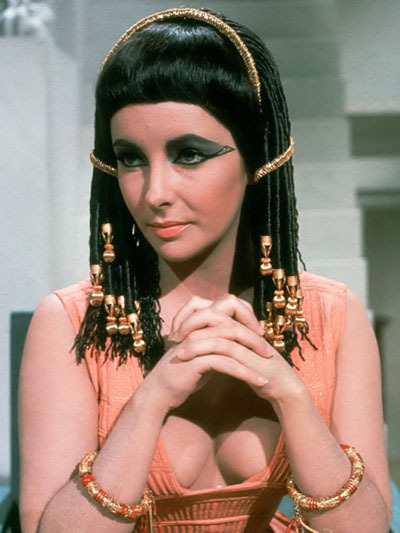
The making of a Muse
Kat Russell discovers what it is that makes a style icon.
What distinguishes fashion from style? The former is transitory, underlined by style, which it perpetually draws upon and interprets according to the season’s trends. Observing fashion’s greatest muses demonstrates the timelessness of style. Monroe’s sumptuous hot pink gown proved Gentlemen Prefer Blondes in 1953, then reappeared, no less exquisite, with Madonna’s Material Girl video thirty one years later. To study the traits that gave style’s most iconic muses such a lasting influence is one of the most worthwhile when considering how we can enhance our own style.
1. Cleopatra (Or Elizabeth Taylor if we’re being picky)

Surely among the earliest muses, Cleopatra’s excesses have ensured her lasting fame. The blunt, fringed haircuts and beaded jewelry of the 1920s point to a revival of her influence with the discovery of Tutankhamen’s tomb in 1922. Today’s gold headbands, thick eyeliner and maxi dresses prove she continues to exert an influence, even if we are drawing from a slightly fictitious, modernized image.
2. Marie Antoinette
In 18th century France, the Queen Marie Antoinette’s extravagant clothing brought both her execution and established her status as a style icon. Whereas Cleopatra stands out for exemplifying contemporary fashion, Antoinette broke the rules. Her suggestive bodices, purple fabrics and gaudy diamonds offended contemporaries. As with so many of fashion’s muses, Antoinette had no fear of attention, no sense of restraint- traits common among fashion’s most prominent patrons since.
3. Luisa Casati
The outrageous Luisa Casati, as frivolous and decadent as Antoinette, commissioned her own portraits by eminent artists, declaring ‘I want to live forever as a work of art’. In many ways, she has. Look to her daring successors, through Grace Jones to Florence Welch, to see the parallels. An Italian heiress, Casati’s fascinating eccentricities have been direct inspiration for numerous designers. Frequently accompanied by her two cheetahs, she was the source of Cartier’s feline motif, as well as their panther jewelry range. For Galliano’s Christian Dior Haute Couture SS98 collection, she was muse. To perceive the ways in which Casati’s untamed flamboyance predated that of so many 21st century collections and style icons- David Bowie, Tilda Swinton and Alexander McQueen among them- requires no effort. However, the anarchy of her wardrobe and behaviour itself helped the rise of masculine tailoring for women in the1950s, a trend that boomed with 1980s power dressing.
4. Kate Moss
Some models embody an era. They become so iconic that they go beyond simply wearing fashion, and come to inspire it. Twiggy’s cropped hair and bold eyelashes (created with the help of three false pairs and extra lashes painted underneath) did this for the swinging 60s. In the 1990s, no one exemplified the turn toward more refined, classic pieces and ethereal beauty than the waif-like Kate Moss. It is difficult to find a way Moss hasn’t helped shape fashion design since the advent of her career: even the progression of her hairstyles has sparked successive waves of imitators. Her status as a muse is reflected in awards, collections that espouse ‘heroin chic’ and the resilience of her career against personal scandal. Like Twiggy, and numerous super models, Moss has also pursued fashion design herself. Evidently, timeless style requires confidence in one’s own judgement and the courage- or ego-to inspire others.
The study of the muse concludes that fashion is confined to clothing, while style incorporates personality, and is therefore more sincere. Our own fashion can be improved immensely through the pursuit of genuine, constant style, like that demonstrated by so many muses. Yet the paradox of the muse is that to be one, it seems, requires the courage to disrupt- not follow- fashion’s norms. In some ways, the worst way to emulate the muse is to copy one. The lesson we take from them is never follow the crowd: be bold and be genuine.









































